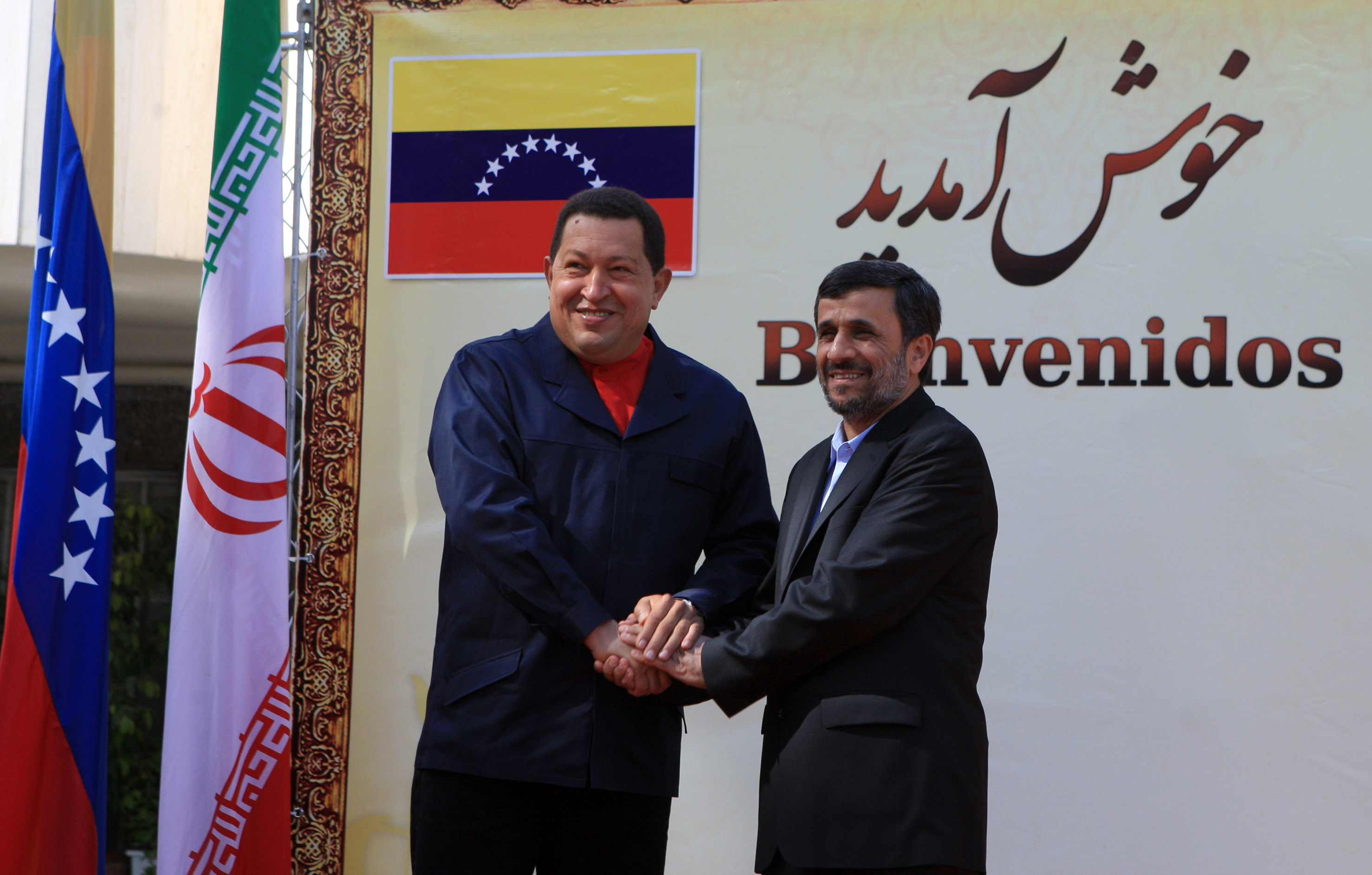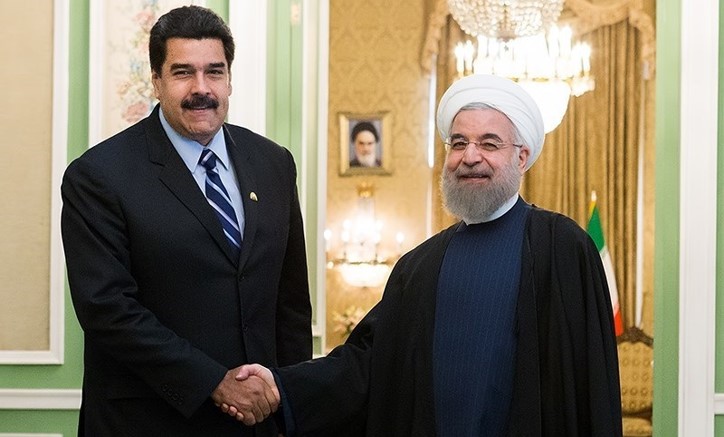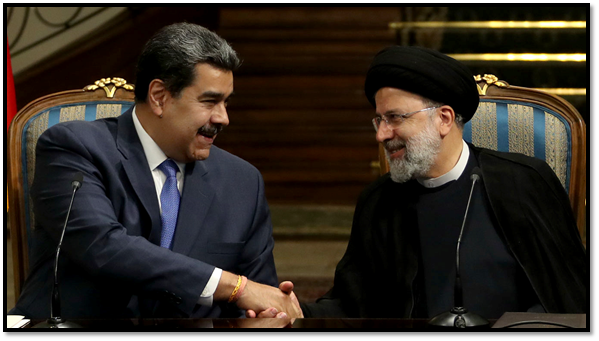Iran and Venezuela formed a strategic partnership to circumvent punitive U.S. sanctions imposed on both countries. In October 2019, Iranian President Hassan Rouhani commended Venezuela’s “praiseworthy” resistance to U.S. pressure. “All their [U.S.] conspiracies against us have failed,” Rouhani said in a meeting with Venezuelan President Nicolas Maduro on the sidelines of the Non-Aligned Movement Summit in Azerbaijan. “Iran and Venezuela have always supported each other in all international and political arenas and will continue to do so.”
In 2022, the two countries signed a 20-year roadmap to boost economic and military cooperation. The agreement was inked during a visit to Tehran by Maduro, who thanked Iran for helping Venezuela repair its oil infrastructure.
Iran-Venezuela ties developed in the 1960s—when the shah was still in power and Venezuela was a young democracy—with cooperation on oil. In 1960, they were two original members—along with Iraq, Kuwait and Saudi Arabia—of the Organization of Petroleum Exporting Countries (OPEC). But under both the monarchy and the theocracy, Iran’s relations with Venezuela were minimal until Hugo Chávez was elected president of Venezuela in 1999.
Khatami and Chávez (1999-2005)
Chávez first visited Iran in May 2001 with a high-level delegation of oil industry, economic and diplomatic officials. In a speech, the Venezuelan leader said that Iran and Venezuela shared a common resistance to U.S. “hegemony and imperialism” and vowed to increase trade and cooperation with Iran.

President Khatami and President Chávez in Tehran in 2004
During the presidency of Mohammad Khatami, Iran and Venezuela steadily increased trade and energy cooperation. In March 2005, President Khatami signed Iran’s first free trade agreement with Venezuela during a visit to Caracas. The agreement, worth $1 billion, included cooperation in mining, shipping, the marine trade, and the oil and gas industry. At the end of Khatami’s term in 2005, Chávez presented him with the Golden Key of the City of Caracas as a token of gratitude.
Ahmadinejad and Chávez (2005-2013)
Both ideologues who often railed against the United States, Iranian President Mahmoud Ahmadinejad and Chávez became political and commercial allies. Between 2005 and 2012, the two countries signed more than 270 accords, including trade deals and agreements on construction projects, automobile production, energy initiatives and banking programs. The two leaders also became personal friends. They often referred to each other as “brothers,” and Chávez once called Ahmadinejad “the gladiator of anti-imperialist struggles.” In 2006, Ahmadinejad presented Chávez with the golden High Medallion of the Islamic Republic Chávez a visit to Tehran.

President Ahmadinejad and President Chávez in Tehran in 2009
Chávez supported Iran’s nuclear program and development of peaceful nuclear technology as a “legitimate right.” In September 2008, Chávez announced that Venezuela was “interested in developing nuclear energy, for peaceful ends of course.” In November 2008, Iran and Venezuela signed a science and technology agreement formalizing cooperation on nuclear technology. In September 2009, Venezuelan Mining Minister Rodolfo Sanz said that Iranian experts were helping Venezuela conduct geological surveys to locate uranium deposits.
Cooperation in the oil and gas industry increased during the Ahmadinejad years. In 2009, Iran and Venezuela established a binational development bank in Caracas with a $200 million investment to support joint economic, industrial and mining projects. Later that year, the countries established a joint oil company and agreed to invest $760 million in each other’s energy sectors.
Rouhani and Maduro (2013-2021)
Chávez died in office in 2013 and was replaced by his Vice President Nicolas Maduro. Ties between Iran and Venezuela diminished. President Rouhani did not initially give priority to relations with Latin America. But in June 2015, the two countries signed six agreements in the economic, financial, technological and scientific fields. In August 2016, Iranian Foreign Minister Mohammad Javad Zarif met with President Maduro in Caracas and vowed to increase economic cooperation.

President Rouhani and President Maduro in Tehran in 2015
Relations increased after the United States reimposed sanctions on Iran in November 2018. In April 2019, Iran’s Mahan Air resumed commercial flights between Tehran and Caracas. Later that year, Iran and Venezuela signed new scientific and technological agreements for cooperation in education, nanotechnology, biotechnology and engineering.
In 2020, Tehran and Caracas boosted cooperation in the oil and gas field to circumvent U.S. sanctions. On April 23, Venezuela announced that it had received materials from Iran to help restart the Cardon refinery, which could produce up to 310,000 barrels of gasoline per day. Planes operated by Iran’s Mahan Air reportedly delivered catalysts, which are chemicals needed to produce gasoline, to Las Piedras airport on the Paraguana peninsula in western Venezuela, where the refinery is located. The United States accused Iran of accepting payment in gold bars to help rebuild Venezuela’s ailing oil industry.
Iran denied the U.S. charge as a “baseless” rumor. “Iran has never received such a consignment,” said Hojattolah Soltani, Iran’s ambassador to Venezuela. He also rejected claims that Iranian experts were helping rebuild Venezuelan refineries.
In May, Venezuela’s refining capabilities reportedly increased from 110,00 barrels per day (bpd) to about 215,000 bpd after the arrival of the spare parts from Iran.
Raisi and Maduro (2021-Present)
Iran and Venezuela expanded ties after President Ebrahim Raisi took office in August 2021. Iran continued delivering badly needed crude oil for refining into fuel. Oil Minister Javad Owji visited Caracas in May 2022 to discuss ways to circumvent U.S. sanctions and repair Venezuelan oil facilities. Iran signed a contract to repair Venezuela's smallest refinery, El Palito, later that month.
In June, Maduro visited Tehran and signed a 20-year cooperation agreement to boost economic and military ties. During his visit, Maduro revealed that General Qassem Soleimani – the commander of the elite Qods Force who was killed by the United States in 2020 – had visited Venezuela in 2019 to offer assistance following cyber attacks on power plants.

President Maduro and President Raisi in Tehran in 2022
Related Material:
Timeline of Bilateral Relations
1960
September: OPEC was formed by Iran, Iraq, Kuwait, Saudi Arabia and Venezuela to co-ordinate and unify petroleum policies.
2001
May: Chávez visited Iran for the first time. The Venezuelan leader commended Iran on its resistance to the United States and vowed to increase trade ties with the Islamic Republic.
2005
March 12: President Khatami inked several bilateral accords during a visit to Caracas, including cooperation on geological and mining projects, shipping and marine trade, and a memorandum of understanding on oil, gas and petrochemistry. The agreements were worth a total of $1 billion. Chávez gifted Khatami the Golden Key of the City of Caracas.
2006
July: Chávez and his oil minister, Rafael Ramírez, visited Tehran and signed agreements for the joint production of nearly a dozen products, including a $4 billion investment in two Venezuelan energy projects by Iranian company Petropars Ltd. The two countries also began construction of a joint methanol facility on Iran’s Persian Gulf coast with an annual capacity of 1.65 million tons.
Iranian President Mahmoud Ahmadinejad praised Chávez as “the brother of the whole Iranian nation” and presented him with the golden High Medallion of the Islamic Republic. “We stand by Iran at every moment, in any situation,” Chávez said upon accepting the award.

A crowd flocked to see Chávez during a trip to Tehran
2007
January 13: President Ahmadinejad met with President Chávez in Caracas to discuss strengthening trade ties. During the talks, Iran and Venezuela agreed to establish a $2 billion investment fund “with the aim of supporting joint economic, industrial and mining projects as well as speeding up the current projects.” Ahmadinejad and Chávez also agreed to press OPEC for output cuts to increase oil prices, which were at a 19-month low.
2008
November: Iran and Venezuela signed an agreement formalizing cooperation on nuclear technology.
2009
March: Iran and Venezuela established a binational development bank in Caracas, the Banco Internacional de Desarrollo. The bank, which was a subsidiary of the Export Development Bank of Iran, was funded at $200 million to support “joint economic, industrial and mining projects as well as speeding up the current projects,” according to Iranian state media.
April: Iranian Defense Minister Mostafa Mohammed Najjar met with Venezuelan officials in Caracas to discuss defense cooperation. It was the first visit by an Iranian defense minister to Venezuela since 1979 Iranian Revolution. The two countries reportedly shared sensitive information on their military developments and capabilities and agreed to joint training exercises.
September 25: Iranian experts were helping Caracas conduct geological surveys to locate uranium deposits, Venezuelan Mining Minister Rodolfo Sanz said. Venezuela had an estimated 50,000 tons of un-mined uranium, which the United States feared could be used to help Iran develop a nuclear weapon.
October: Iran and Venezuela established a joint oil company, Beniroug, headquartered in Spain. Tehran agreed to pay for Venezuelan gasoline by investing in Venezuela’s energy projects.
2010
Iran and Venezuela agreed to invest $760 million in each other’s energy sectors. Venezuela pledged to export 20,000 barrels of gasoline per day to Iran.
2012
January: President Ahmadinejad met with President Chávez in Caracas. The two leaders signed agreements in the areas of industry, science, technology and politics. They vowed to unite in resistance to the United States. “It's clear they are afraid of our development,” Ahmadinejad said. “Our weapon is logic. Our weapon is culture. Our weapons are human values.”
2013
March 5: Chávez died after 14 years in office. Ahmadinejad attended his funeral in Caracas. He declared a national day of mourning in Iran and offered a personal tribute to the late president. “He is alive, as long as nations are alive and struggle for consolidating independence, justice and kindness,” Ahmadinejad wrote in a letter published by the semi-official Mehr News Agency. “I have no doubt that he will come back, and along with Christ the Savior, the heir to all saintly and perfect men, and will bring peace, justice and perfection for all.”
2015
January 12: President Maduro met with President Rouhani in Tehran during his tour of OPEC countries. The two leaders pledged to work together to stabilize global oil prices. Maduro said that plummeting oil prices were the product of a “geopolitical war” with the United States.
June 26: Iran and Venezuela inked six agreements in the economic, financial, technological and scientific fields. President Maduro agreed to a $500 million credit line to fund joint investments and help improve supplies of basic goods and necessities, including drugs and surgical equipment.
November 23: President Rouhani met with President Maduro in Tehran to discuss oil prices and trade ties. “Tehran is fully ready to expand scientific and educational cooperation with the Venezuelan part, to meet Venezuelans trade and industrial demands and to implement joint projects based on the previous agreements,” Rouhani said .
2016
August 26: Iranian Foreign Minister Zarif met with President Maduro in Caracas to discuss trade ties. Venezuela launched a special commission to push forward bilateral deals signed in 2015. “We are advancing in our bilateral cooperation as well as in matters of mutual interest for economic development...we are going to create a new dynamism in Venezuela-Iran relations,” President Maduro said.
2019
April: Iran’s Mahan Air resumed commercial flights between Tehran and Caracas. Flights between the two capitals were halted in 2010.
April 15: Secretary of State Mike Pompeo accused Iran of meddling in Venezuela. “Iranian money remains in South America being used for malign purposes, supporting Hezbollah, supporting transnational criminal organizations, supporting efforts at terrorism throughout the region,” Pompeo told the Voice of America.
November: Iran and Venezuela signed new scientific and technological agreements in “education, nanotechnology, biotechnology and engineering," according to the Venezuelan government. Caracas did not provide additional details about the deal.
2020
January 8: Venezuelan Defense Minister Vladimir Lopez condemned the U.S. killing of Iranian General Qassem Soleimani. “I extend my heartfelt condolences to you and the people of Iran on behalf of the Venezuelan armed forces, the people of my country and all the commanders.” Lopez said in a phone call to Iranian Defense Minister Amir Hatami. “We will side with Iran to fight the (global) arrogance.”
May: The first Iranian oil shipments arrived in Venezuelan waters. The flotilla of five ships carried 1.5 million barrels of gasoline. “Iran and Venezuela have always supported each other in times of difficulty,” Venezuelan Foreign Minister Jorge Arreaza tweeted. “Today, the first ship with gasoline arrives for our people.” President Rouhani warned of retaliation if the United States interfered with the gasoline shipment. “We hope the Americans will not make a mistake,” he said.
June 8: Iran sent medical equipment to Venezuela to help stem the COVID-19 outbreak. "Right now, what we are receiving is different types of testing kits,” Venezuelan Planning Minister Ricardo Menendez said on state television.
June 21: The Golsan, an Iranian cargo ship, delivered 23,000 tons of food to Venezuela to stock the first Iranian supermarket. The Iranian embassy in Caracas praised the delivery as "another success in friendly and fraternal relations."
September-October: Three more Iranian tankers arrived in Venezuela carrying around 815,000 barrels of gasoline.
November: Iranian Foreign Minister Zarif traveled to Venezuela as part of a five-day trip to Latin America. He met with President Maduro and his Venezuelan counterpart, Foreign Minister Jorge Arreaza. "[This] visit ratifies the unshakeable spirit of the strategic relations of cooperation and solidarity between Iran and Venezuela," Maduro tweeted after their meeting.
December: Iran sent a new flotilla of 10 tankers to resupply Venezuela with oil. Abrams, the U.S. special representative for Iran and Venezuela, said that Washington is “watching what Iran is doing and making sure that other shippers, insurers, ship owners, ship captains realize they must stay away from that trade.” Iran also used false call-signs to help Venezuela export its oil, Bloomberg reported.
2021
May: U.S. officials told Politico that two Iranian warships – one potentially carrying seven fast attack craft – could be headed to Venezuela. Tehran warned the United States not to interfere with the transit of the two warships. “Iran is always present in international waters and has this right under international law," Foreign Ministry spokesperson Saeed Khatibzadeh told reporters. "No country can violate this right."
June: The two Iranian warships rounded the Cape of Good Hope and entered the Atlantic Ocean. The Pentagon said that delivery of weapons to Venezuela would be a "provocative act" and a "threat" to U.S. partners in the Western Hemisphere. "We would reserve the right to take appropriate measures - in concert with our partners - to deter the delivery or transit of such weapons," spokesperson John Kirby told CNN in a statement. The Biden administration also warned Venezuela and Cuba not to permit the warships to dock. The two ships turned off course and instead headed north up the African west coast, Politico reported on June 17.
July: The two Iranian warships had sailed north past Spain and were nearing the English Channel, according to satellite imagery. They were likely headed to the Baltic Sea for a Russian naval parade on July 25, U.S. Naval Institute News reported.
Today we spotted the #MAKRAN steam up the northwest coast of France, some 65km west-by-southwest of Penmarch. They didn't continue in a straight line from Portugal but seem to have taken a minor detour to scope the coastline. pic.twitter.com/sDgkxzk1jB
— TankerTrackers.com, Inc. (@TankerTrackers) July 18, 2021
2022
March: An Iran-flagged ship transferred oil to a Venezuela-owned tanker in a remote part of the Indian Ocean near the Maldives, according to Reuters.
Mid-April: Iran delivered at least 200,000 barrels of heavy crude oil to Venezuela’s second largest refinery, Cardon.
May 3: Iranian Oil Minister Javad Owji discussed ways to overcome the impact of U.S. sanctions with Venezuelan President Maduro in Caracas. “A productive meeting to deepen the ties of brotherhood and cooperation, in energy matters,” Maduro tweeted. Owji also met with his counterpart, Tareck El Assaimi.
May: Iran’s Dino I tanker delivered 400,000 barrels of crude oil to Venezuela.
May 13: The National Iranian Oil Engineering and Construction Company signed a $115 million contract to repair Venezuela's smallest refinery, El Palito.
June 11: Iran and Venezuela signed a 20-year cooperation agreement on day two of President Maduro’s visit to Tehran. The roadmap outlined expanded economic and military ties, including closer cooperation in the oil and petrochemical industries. “The Islamic Republic of Iran’s foreign policy has always been to have relations with independent countries, and Venezuela showed that it has had incredible resistance against threats and sanctions by enemies and imperialism,” Raisi said at the signing. Maduro announced that a direct flight from Caracas to Tehran would start on July 18.
Maduro also met with Supreme Leader Khamenei, who lauded Venezuela for opposing the United States and supporting the Palestinian cause. “The successful experience of the two countries has shown that the only way to counter the heavy pressures and hybrid war of the U.S. is to stand up against it and resist,” Khamenei said. Maduro thanked Iran for its assistance while under U.S. sanctions. “You came to our aid when Venezuela was in a very difficult condition and no country was helping. You did help us to get out of that situation.”

Khamenei, Maduro and Raisi on June 11, 2022
Alex Yacoubian, a program assistant at the U.S. Institute of Peace, assembled this report. Andrew Hanna, a program specialist at the U.S. Institute of Peace, contributed.
